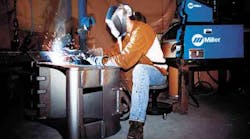Welding is an essential skill in almost any forging operation, as die and tool repair is a critical function in prolonging performance and productivity. Gas metal arc welding (GMAW) or deposition welding is the standard method for repairing worn parts, which even so is a time-consuming process, with an average feed rate of five kilos per hour.
Because the dilution level is around 30%, several layers must be deposited, one on the other, until the requisite surface material profile is achieved.
Scientists at the Laser Zentrum Hannover e.V. (LZH), in Hanover, Germany, have developed a laser-supported, light arc process that achieves this in a single layer. The development emerged from the "HoDopp” research project, “High-power laser cladding using the twin-wire technique without light-arc transmission and with laser-assisted weld-penetration control."
It was financed by Germany’s Federal Ministry of Education and Research, and completed at the end of 2014.
In the conventional GMAW process, the light arc burns between the wire electrode and the workpiece and fuses both. For large areas and multi-layer coatings, the process can take up to 24 hours per square meter.
In the HoDopp process, a light arc burns between two wires and melts them simultaneously. Thus, the deposition rate can be increased to around 7.5 kilograms per hour. The laser beam used in addition to this ensures layer adherence and improves the form of the seam.
Due to the support of the laser beam, the layer is deposited with a low penetration depth, and the dilution rate is thus under 5%.
A further advantage of the process is low heat input. Component deformation is notably lower than with deposition welding using conventional GMAW, and the deposition rate can be increased by around 50%. Since one layer replaces two or three conventionally deposited layers, time and material can be saved for inhomogeneous materials, by half to two-thirds. Thus, productivity and welding-process quality can be increased simultaneously, and by a significant margin.










